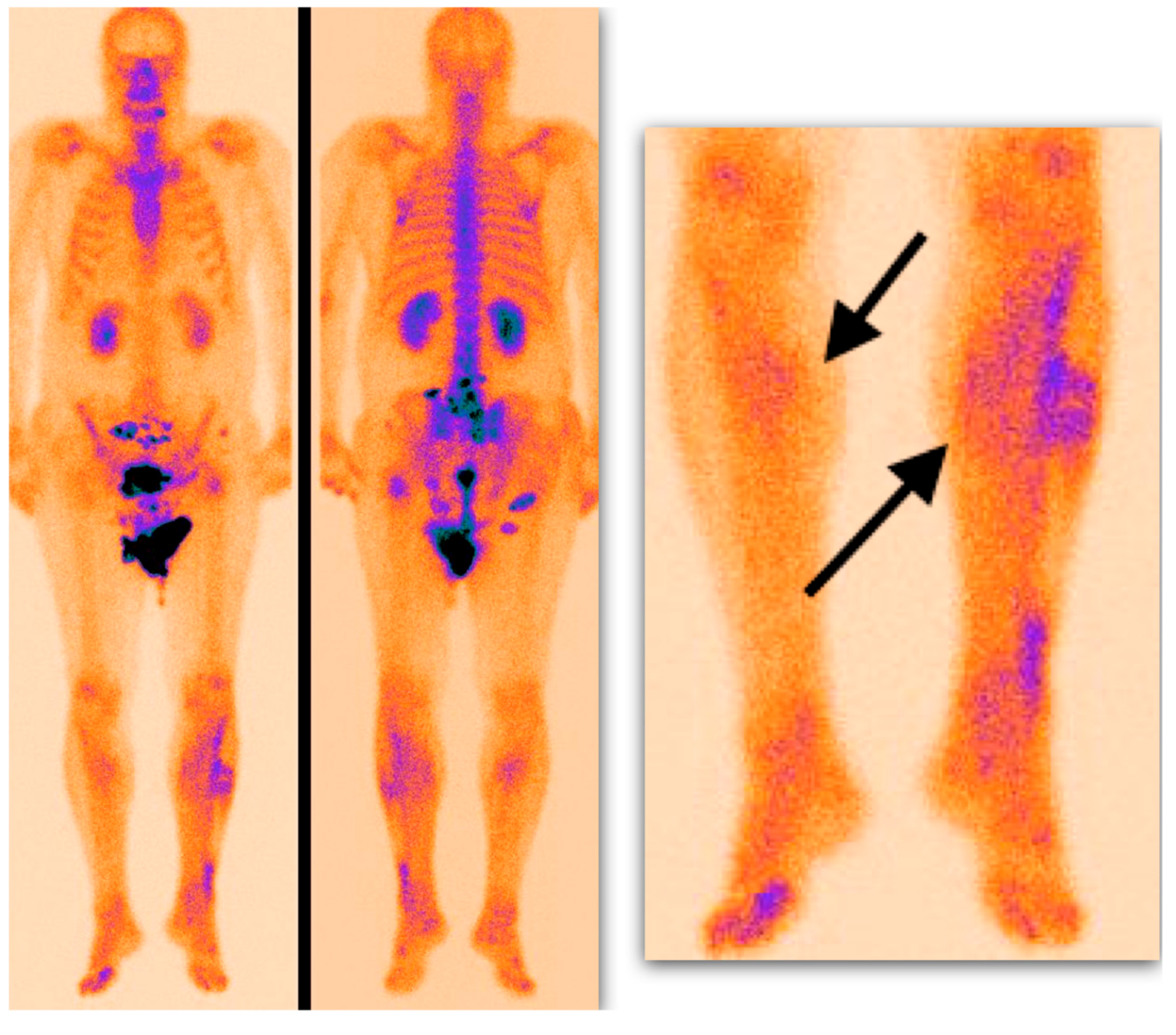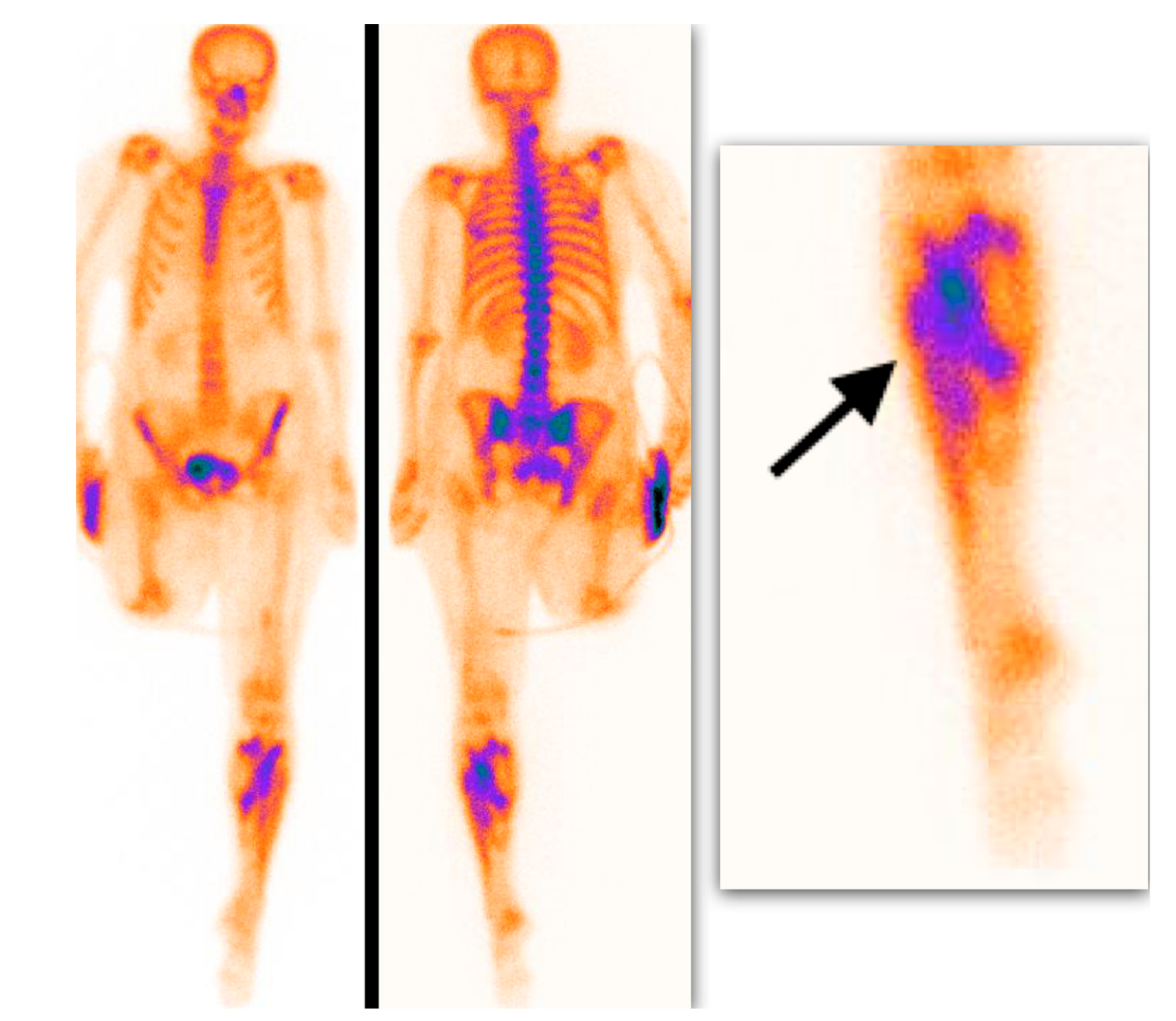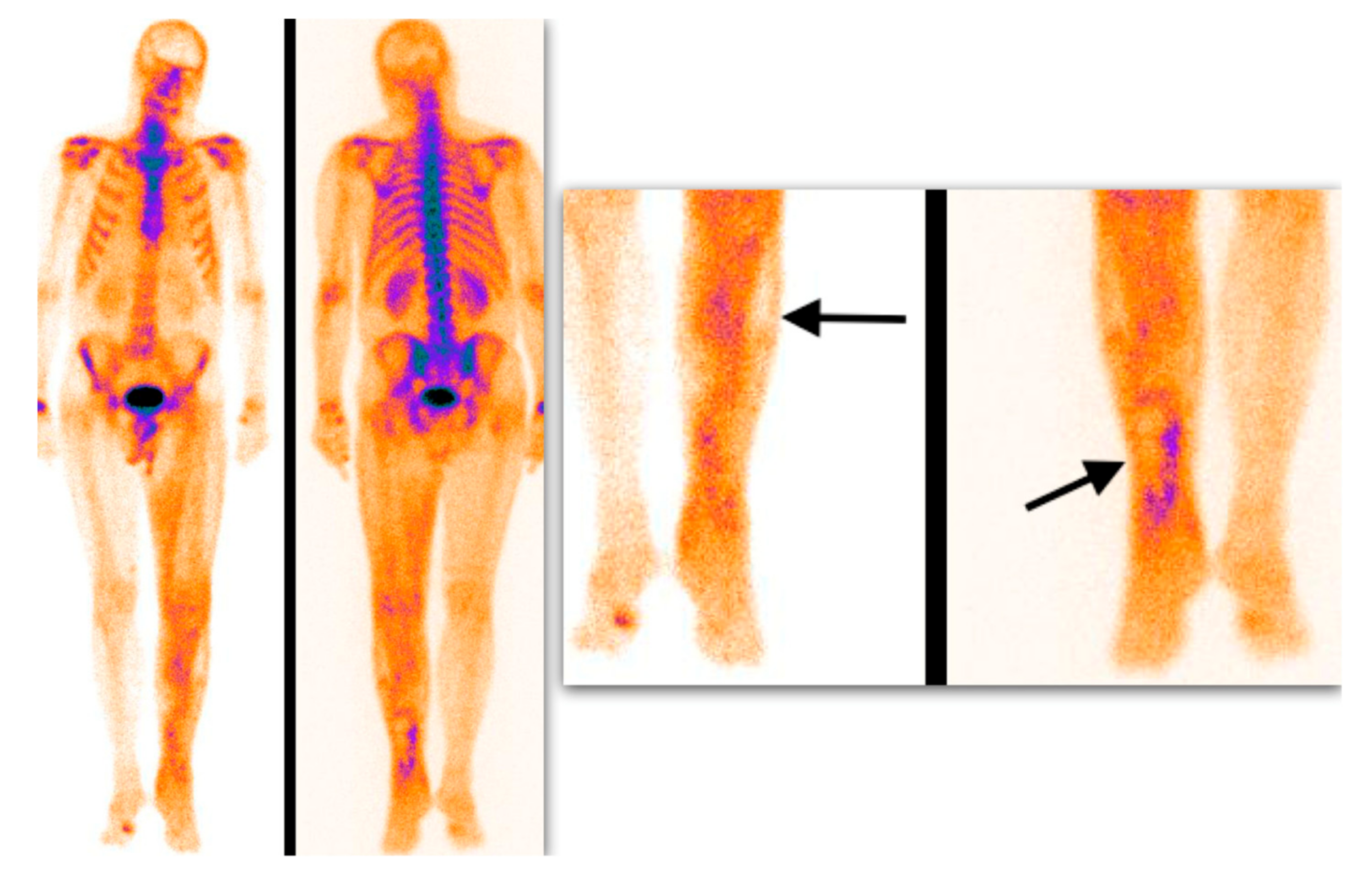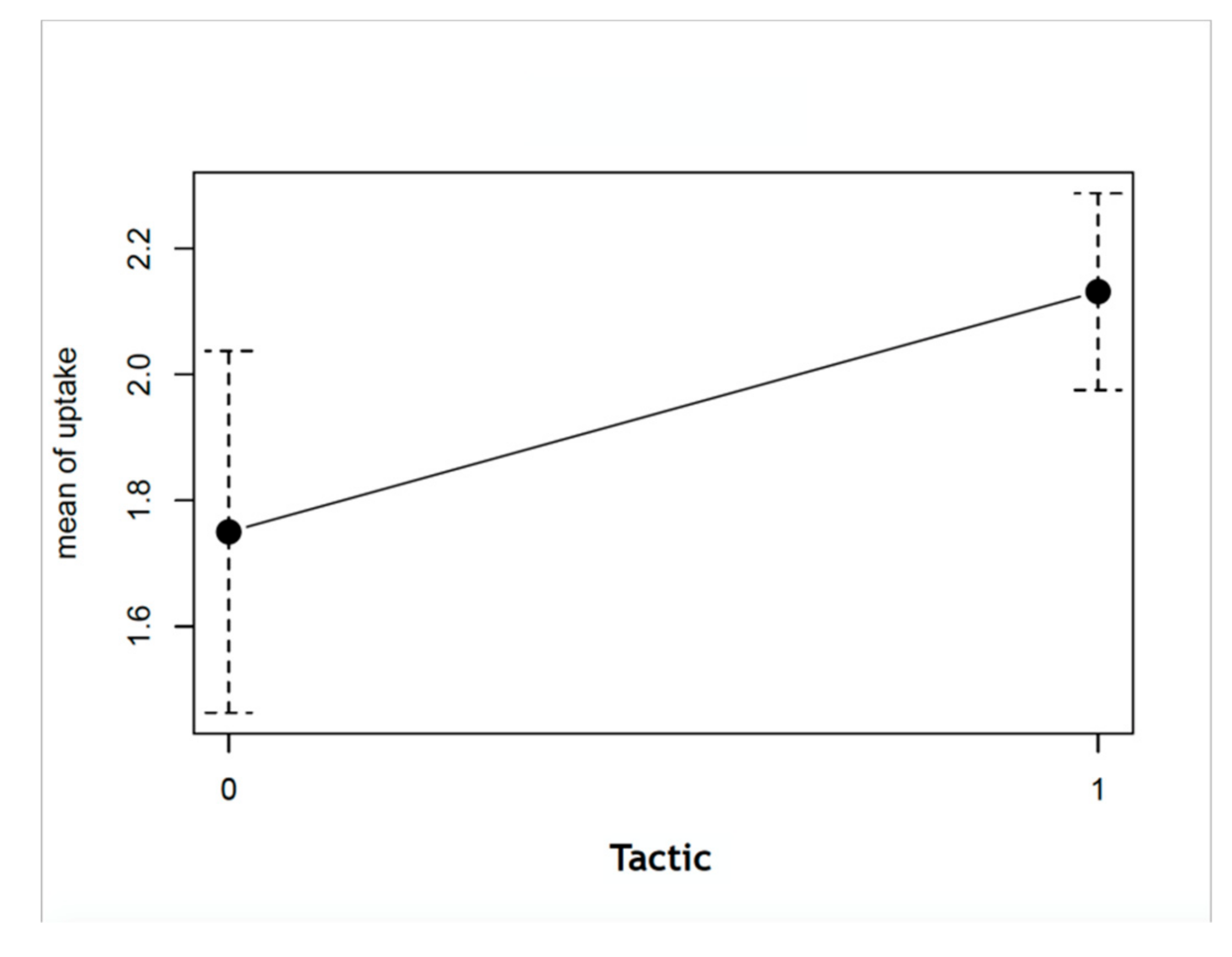Ischemic Muscle Necrosis of Lower Extremities in Peripheral Arterial Disease: The Impact of 99mTc-MDP Scintigraphy on Patient Management
Abstract
1. Introduction
2. Materials and Methods
2.1. Patients
2.2. Scintigraphy
2.3. Image Analysis
2.4. Statistical Analysis
3. Results
4. Discussion
5. Conclusion
Author Contributions
Funding
Conflicts of Interest
References
- Sarikaya, A.; Top, H.; Aygit, A.C.; Benlier, E.; Unal, Y. Predictive value of 99mTc-sestamibi scintigraphy for healing of extremity amputation. Eur. J. Nucl. Med. Mol. Imaging 2006, 33, 1500–1507. [Google Scholar] [CrossRef]
- Masaoka, S. Evaluation of arterial obstructive leg and foot disease by three-phase bone scintigraphy. Ann. Nucl. Med. 2001, 15, 281–287. [Google Scholar] [CrossRef] [PubMed]
- Yao, J.S.T.; Peterson, L.K.; Payne, K. Lower limb systolic pressure measurements: Technique and clinical applications. Int. Angiol. 1985, 4, 31–39. [Google Scholar] [PubMed]
- Peller, P.J.; Ho, V.B.; Kransdorf, M.J. Extraosseous Tc-99m MDP uptake: A pathophysiologic approach. RadioGraphics 1993, 13, 715–734. [Google Scholar] [CrossRef] [PubMed]
- Bajnok, L.; Kozlovszky, B.; Varga, J.; Antalffy, J.; Olvaszto, S.; Fulop, T. Technetium-99m sestamibi scintigraphy for the assessment of lower extremity ischaemia in peripheral arterial disease. Eur. J. Nucl. Med. 1994, 21, 1326–1332. [Google Scholar] [CrossRef]
- Burgess, E.M.; Marsden, F.W. Major lower extremity amputations following arterial reconstruction. Arch. Surg. 1974, 108, 655–660. [Google Scholar] [CrossRef]
- Romano, R.L.; Burgess, E.M. Level selection in lower extremity amputations. Clin. Orthop. 1971, 74, 177–184. [Google Scholar] [CrossRef]
- Burgess, E.M.; Romano, R.L.; Zettl, J.H.; Schrock, R.D., Jr. Amputations of the leg for peripheral vascular insufficiency. J. Bone Jt. Surg. Am. 1971, 53, 874–890. [Google Scholar] [CrossRef]
- Welch, G.H.; Leiberman, D.P.; Pollock, J.G.; Angerson, W. Failure of Doppler ankle pressure to predict healing of conservative forefoot amputations. Br. J. Surg. 1985, 72, 888–891. [Google Scholar] [CrossRef]
- Malone, J.M.; Anderson, G.G.; Lalka, S.G.; Hagaman, R.M.; Henry, R.; McIntyre, K.E.; Bernhard, V.M. Prospective comparison of noninvasive techniques for amputation level selection. Am. J. Surg. 1987, 154, 179–184. [Google Scholar] [CrossRef]
- Malone, J.M.; Leal, J.M.; Moore, W.S.; Henry, R.E.; Daly, M.J.; Patton, D.D.; Childers, S.J. The “gold standard” for amputation level selection xenon-133 clearance. J. Surg. Res. 1981, 30, 449–455. [Google Scholar] [CrossRef]
- Dwars, B.J.; Rauwerda, J.A.; van den Broek, T.A.; den Hollander, W.; Heidendal, G.A.; van Rij, G.L. A modified scintigraphic technique for amputation level selection in diabetics. Eur. J. Nucl. Med. 1989, 15, 38–41. [Google Scholar] [CrossRef] [PubMed]
- Seder, J.S.; Botvinick, E.H.; Rahimtoola, S.H.; Goldstone, J.; Price, D.C. Detecting and localizing peripheral arterial disease: Assessment of 201Tl. AJR 1981, 137, 373–380. [Google Scholar] [CrossRef] [PubMed]
- Sayman, H.B.; Urgancioglu, I. Muscle perfusion with technetium-MIBI in lower extremity peripheral arterial disease. J. Nucl. Med. 1991, 32, 1700–1703. [Google Scholar] [PubMed]
- Mochizuki, T.; Tauxe, W.N.; Perper, J.A. Technetium-99m MDP scintigraphy of rhabdomyolysis induced by exertional heat stroke: A case report. Ann. Nucl. Med. 1990, 4, 111–113. [Google Scholar] [CrossRef]
- Tittel, K.; Spitz, J.; Gips, J. Detection of ischemic muscle necroses using 99mTc perfusion scintigraphy of traumatized extremities. Unfallchirurgie 1987, 13, 55–59. [Google Scholar] [CrossRef]
- Bhatnagar, A.; Sarker, B.B.; Sawroop, K.; Chopra, M.K.; Sinha, N.; Kashyap, R. Diagnosis, characterization and evaluation of treatment response of frostbite using pertechnetate scintigraphy: A prospective study. Eur. J. Nucl. Med. Mol. Imaging 2002, 29, 170–175. [Google Scholar] [CrossRef]
- O’Donoghue, J.P.; Powe, J.E.; Mattar, A.G.; Hurwitz, G.A.; Laurin, N.R. Three-phase bone scintigraphy. Asymmetric patterns in the upper extremities of asymptomatic normals and reflex sympathetic dystrophy patients. Clin. Nucl. Med. 1993, 18, 829–836. [Google Scholar] [CrossRef]
- Wolfram, R.M.; Budinsky, A.C.; Sinzinger, H. Assessment of peripheral arterial vascular disease with radionuclide techniques. Semin. Nucl. Med. 2001, 31, 129–142. [Google Scholar] [CrossRef]
- Sayman, H.B.; Urgancioglu, I.; Uslu, I.; Kapicioglu, T. Prediction of muscle viability after electrical burn necrosis. Clin. Nucl. Med. 1992, 17, 395–396. [Google Scholar] [CrossRef]
- Miles, K.A.; Barber, R.W.; Wraight, E.P.; Cooper, M.; Appleton, D.S. Leg muscle scintigraphy with 99Tcm-MIBI in the assessment of peripheral vascular (arterial) disease. Nucl. Med. Commun. 1992, 13, 593–603. [Google Scholar] [CrossRef] [PubMed]
- Aygıt, C.; Sarıkaya, A. Technetium–99m sestamibi scintigraphy for non-invasive assessment of muscle flap viability. Ann. Plast. Surg. 1999, 43, 338–340. [Google Scholar] [CrossRef] [PubMed]
- Sarıkaya, I.; Aygıt, A.C.; Candan, L.; Sarıkaya, A.; Türkyılmaz, M.; Berkarda, Ş. Assessment of tissue viability in frostbite injury by technetium-99m-sestamibi scintigraphy in an experimental rabbit model. Eur. J. Nucl. Med. 2000, 27, 41–45. [Google Scholar] [CrossRef] [PubMed]
- Sarıkaya, A.; Şen, Ş.; Çermik, T.F.; Birtane, M.; Berkarda, Ş. Evaluation of skeletal muscle metabolism and erythropoietin treatment response in patients with chronic renal failure with 99mTc-sestamibi leg scintigraphy. Nucl. Med. Commun. 2000, 21, 83–87. [Google Scholar] [CrossRef] [PubMed]
- Pekindil, Y.; Sarıkaya, A.; Birtane, M.; Pekindil, G.; Salan, A. 99mTcsestamibi muscle scintigraphy to assess the response to neuromuscular electrical stimulation of normal quadriceps femoris muscle. Ann. Nucl. Med. 2001, 15, 397–401. [Google Scholar] [CrossRef]
- Sarıkaya, A.; Sarikaya, I.; Pekindil, G.; Firat, M.F.; Pekindil, Y. Technetium-99m sestamibi limb scintigraphy in post-traumatic reflex sympathetic dystrophy: Preliminary results. Eur. J. Nucl. Med. 2001, 8, 1517–1522. [Google Scholar] [CrossRef]
- Aygit, A.C.; Sarıkaya, A. Imaging of frostbite injury by technetium-99m-sestamibi scintigraphy: A case report. Foot Ankle Int. 2002, 23, 56–59. [Google Scholar] [CrossRef]
- Sarıkaya, A.; Aygit, A.C. Combined 99mTc MDP bone SPECT and 99mTc sestamibi muscle SPECT for assessment of bone regrowth and free muscle flap viability in an electrical burn of scalp. Burns 2003, 29, 385–388. [Google Scholar] [CrossRef]
- Sarıkaya, A.; Ege, T.; Fırat, M.F.; Enver, D. Assessment of digital ischemia and evaluation of response to therapy by technetium-99m sestamibi limb scintigraphy after local cooling of hand in patients with vasospastic Raynaud’s syndrome. Nucl. Med. Commun. 2004, 25, 207–211. [Google Scholar] [CrossRef]
- Top, H.; Sarikaya, A.; Aygit, A.C.; Benlier, E.; Kiyak, M. Review of monitoring of free muscle flap transfers in reconstructive surgery: Role of 99mTc sestamibi scintigraphy. Nucl. Med. Commun. 2006, 27, 91–98. [Google Scholar] [CrossRef]
- Beanlands, R.S.B.; Dawood, F.; Wen, W.H.; McLaughlin, P.R.; Butany, J.; D’Amati, G.; Liu, P.P. Are the kinetics of technetium-99mmethoxyisobutyl isonitrile affected by cell metabolism and viability? Circulation 1990, 82, 1802–1814. [Google Scholar] [CrossRef] [PubMed]
- Piwnica-Worms, D.; Kronauge, J.F.; Chiu, M.L. Uptake and retention of hexakis (2-methoxyisobutyl isonitrile) technetium (I) in cultured chick myocardial cells. Mitochondrial and plasma membrane potential dependence. Circulation 1990, 82, 1826–1838. [Google Scholar] [CrossRef] [PubMed]
- Timmons, J.H.; Hartshorne, M.F.; Peters, V.J.; Cawthon, M.A.; Bauman, J.M. Muscle necrosis in the extremities: Evaluation with Tc-99m pyrophosphate scanning—A retrospective review. Radiology 1988, 167, 173–178. [Google Scholar] [CrossRef] [PubMed]
- Subramaniam, G.; McAfee, J.G.; Blair, R.J.; Kallfelz, F.A.; Thomas, F.D. Tc-99m methylene diphosphonate: A superior agent for skeletal imaging: Comparison with other technetium complexes. J. Nucl. Med. 1975, 16, 744–755. [Google Scholar]
- Silbertstein, E.B.; Francis, M.D.; Tofe, A.J.; Slough, C.L. Distribution of 99mTc-Sn-diphosphonate and free 99Mtc pertechnetate in selected soft and hard tissues. J. Nucl. Med. 1975, 16, 58–61. [Google Scholar]
- Buja, L.M.; Tofe, A.J.; Kulkarni, P.V.; Mukherjee, A.; Parkey, R.W.; Francis, M.D.; Bonte, F.J.; Willerson, J.T. Sites and mechanisms of localization of technetium 99m phosphorus radiopharmaceuticals in acute myocardial infarcts and other tissues. J. Clin. Investig. 1977, 60, 724–740. [Google Scholar] [CrossRef]
- Siegal, B.A.; Engel, W.K.; Derrer, E.C. Localization of technetium-99m diphosphonate in acutely injured muscle: Relationship to muscle calcium deposition. Neurology 1977, 27, 230–238. [Google Scholar] [CrossRef]






| Primary Treatment | Amputation | Fasciotomy | Shunting | Thrombectomy | None |
|---|---|---|---|---|---|
| 18 (36%) | 4 (8%) | 10 (20%) | 17 (34%) | 1 (2%) |
| Grade I | Grade II | Grade III | |
|---|---|---|---|
| Conservative | 3 | 9 | 0 |
| Aggressive | 2 | 29 | 7 |
| Before Re-Operation | After Re-Operation | p-Value | |
|---|---|---|---|
| K, mmol/L | 3.91 ± 0.43 | 3.90 ± 0.81 | 0.973 |
| Urea, mmol/L | 12.0 ± 9.4 | 4.7 ± 1.3 | 0.207 |
| CRP, mg/L | 142.9 ± 99.0 | 84.8 ± 77.8 | 0.142 |
| Statistical Measure | Percentage | 95% CI |
|---|---|---|
| Sensitivity | 97% | 85.84 to 99.93% |
| Specificity | 31% | 9.09 to 61.43% |
| Positive Predictive Value | 80% | 73.50 to 85.23% |
| Negative Predictive Value | 80% | 32.92 to 97.02% |
| Accuracy | 80% | 66.28 to 89.97% |
© 2019 by the authors. Licensee MDPI, Basel, Switzerland. This article is an open access article distributed under the terms and conditions of the Creative Commons Attribution (CC BY) license (http://creativecommons.org/licenses/by/4.0/).
Share and Cite
Jocius, D.; Vajauskas, D.; Skrebunas, A.; Gutauskas, M.; Tamosiunas, A.E. Ischemic Muscle Necrosis of Lower Extremities in Peripheral Arterial Disease: The Impact of 99mTc-MDP Scintigraphy on Patient Management. Medicina 2019, 55, 763. https://doi.org/10.3390/medicina55120763
Jocius D, Vajauskas D, Skrebunas A, Gutauskas M, Tamosiunas AE. Ischemic Muscle Necrosis of Lower Extremities in Peripheral Arterial Disease: The Impact of 99mTc-MDP Scintigraphy on Patient Management. Medicina. 2019; 55(12):763. https://doi.org/10.3390/medicina55120763
Chicago/Turabian StyleJocius, Donatas, Donatas Vajauskas, Arminas Skrebunas, Marijus Gutauskas, and Algirdas Edvardas Tamosiunas. 2019. "Ischemic Muscle Necrosis of Lower Extremities in Peripheral Arterial Disease: The Impact of 99mTc-MDP Scintigraphy on Patient Management" Medicina 55, no. 12: 763. https://doi.org/10.3390/medicina55120763
APA StyleJocius, D., Vajauskas, D., Skrebunas, A., Gutauskas, M., & Tamosiunas, A. E. (2019). Ischemic Muscle Necrosis of Lower Extremities in Peripheral Arterial Disease: The Impact of 99mTc-MDP Scintigraphy on Patient Management. Medicina, 55(12), 763. https://doi.org/10.3390/medicina55120763




